Dark Cloud Meaning in Bible: God’s Presence
In the Bible, dark clouds symbolize God’s divine presence and majesty, often illustrating His omnipotence and the mystery of His will. Exodus 19:9 and Psalm 18:11 depict dark clouds as manifestations of God’s concealed and formidable presence, inviting reverence and awe.
These clouds also forewarn of judgment, as seen in Ezekiel 30:3, and play a significant role in eschatological visions such as Matthew 24:30. Consequently, dark clouds serve as profound symbols bridging divine transcendence and human perception, highlighting the complexities of divine revelation and judgment.
Exploring these layers reveals deeper theological insights.

Dark Cloud Meaning in the Bible: Divine Presence, Judgment, and Mystery
| Aspect | Details |
|---|---|
| Definition | A cloud that obscures light; often thick and dark |
| Biblical Mentions | Exodus 19:9, 1 Kings 8:10-12, Ezekiel 10:3-4 |
| Symbolic Meaning | Represents God’s presence, mystery, or coming judgment |
| Spiritual Insight | God often appears in a cloud to signal power and holiness |
| Moral Lesson | Encourages reverence and awareness of God’s hidden yet powerful nature |
Symbolism in Biblical Literature
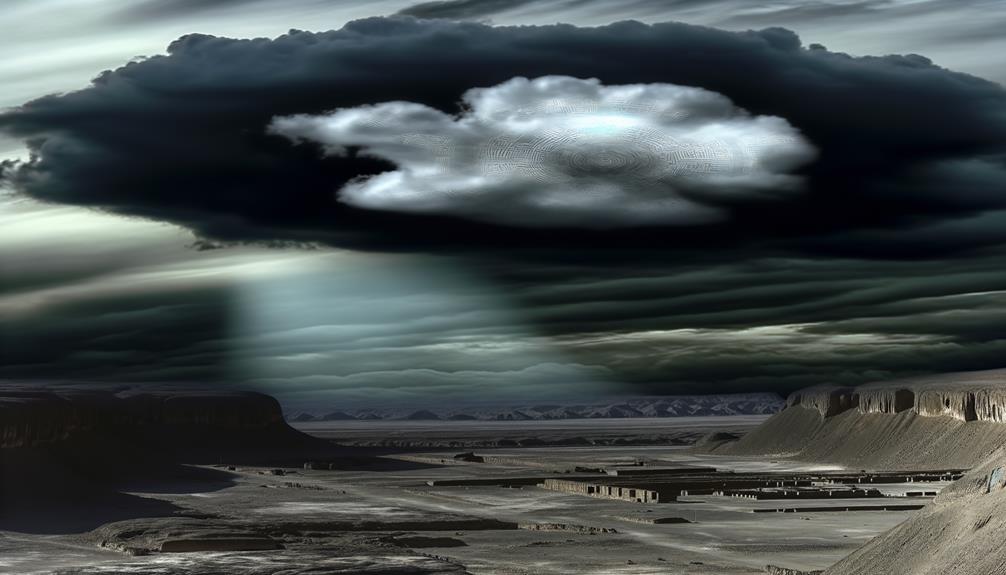
In Biblical literature, symbolism serves as a profound vehicle for conveying spiritual truths and divine messages.
Symbols like the dark cloud are not mere literary devices but pivotal elements imbued with theological significance. The dark cloud, for example, frequently represents God’s inscrutable nature and the mystery surrounding His divine will.
This symbolic usage can be seen in passages such as Exodus 19:9, where a dense cloud signifies God’s presence on Mount Sinai, veiling His majesty yet indicating His nearness. Such imagery invites readers to contemplate the layers of meaning beyond the literal text, fostering a deeper understanding of divine mysteries.
Consequently, symbolism in Biblical texts functions as a bridge between the tangible and the transcendent, enriching the spiritual narrative.
Divine Presence and Majesty
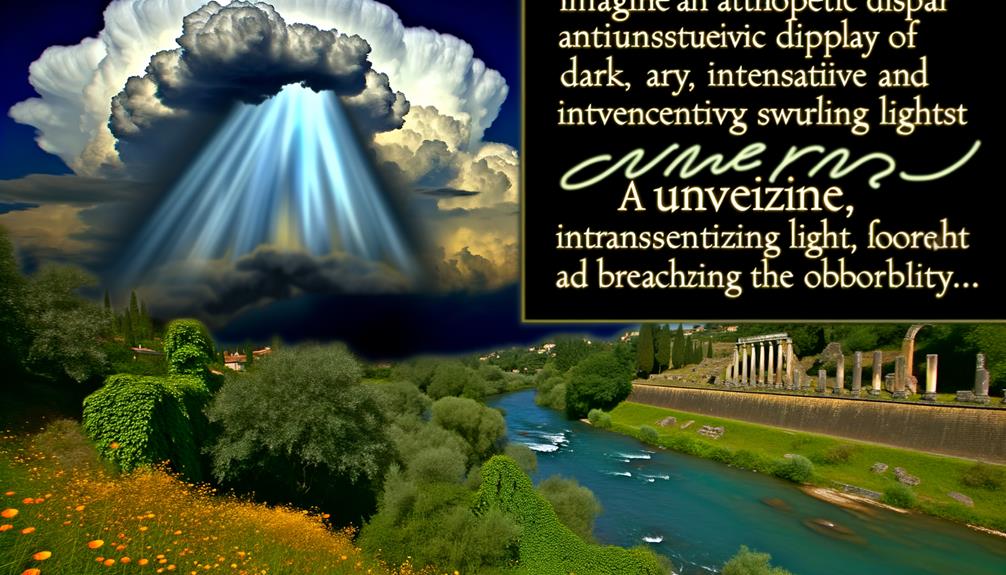
The dark cloud in biblical texts often serves as a profound manifestation of God’s divine presence and majesty, encapsulating the awe-inspiring and mysterious aspects of His nature. This imagery appears in various scriptural contexts, symbolizing both His omnipotence and the inscrutability of His will.
For instance, in Exodus 19:9, the Lord’s descent in a thick cloud conveys His supreme authority and sanctity. Similarly, 1 Kings 8:12 emphasizes, ‘The Lord has said that he would dwell in thick darkness,’ illustrating that His divine essence transcends human understanding.
These depictions reinforce the notion that God’s presence, though enveloped in darkness, is a source of profound reverence and infinite power, inviting believers to approach Him with humility and awe.
Dark Clouds on Mount Sinai

Frequently depicted in the scriptures, the dark clouds on Mount Sinai symbolize the profound mystery and formidable power of God’s presence during the giving of the Law to Moses.
Exodus 19:16-19 describes an awe-inspiring scene where a thick cloud envelops the mountain, accompanied by thunder, lightning, and the sound of a trumpet. This theophany highlights the transcendence and holiness of God, as well as the gravity of the divine covenant established with Israel.
The dark clouds serve as a tangible manifestation of God’s unapproachable majesty, instilling reverence and fear. This imagery underscores the momentous nature of the revelation, emphasizing that the Law is not merely a set of rules but a sacred contract between God and His chosen people.
Prophetic Visions and Judgment
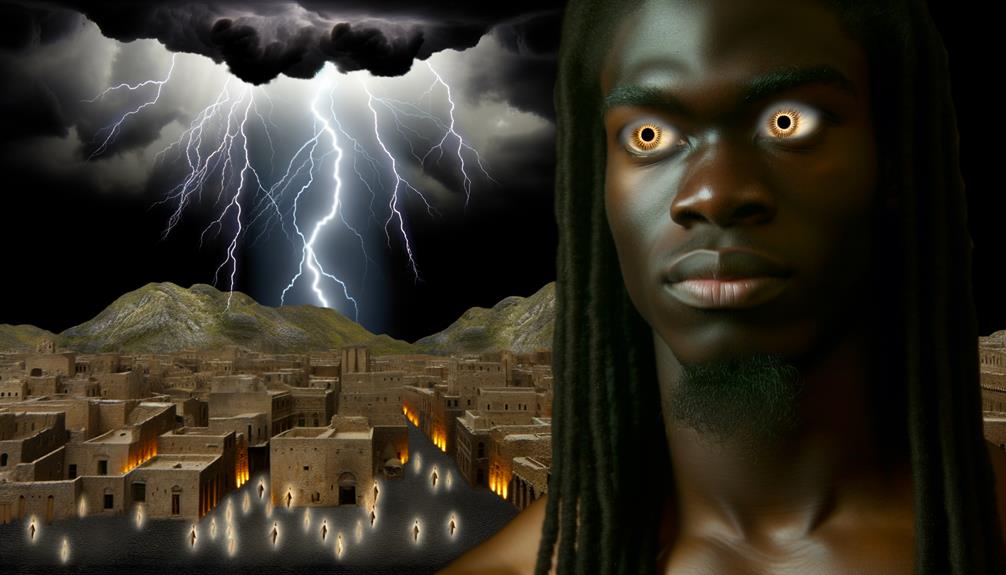
Prophetic visions throughout the Bible often utilize the imagery of dark clouds to symbolize impending judgment and divine wrath.
In Ezekiel 30:3, the prophet speaks of a ‘day of clouds, a time of doom for the nations,’ indicating a period of divine retribution.
Similarly, Joel 2:2 describes a ‘day of darkness and gloom,’ a day of thick clouds, presaging catastrophic divine intervention.
The dark cloud motif serves as a potent symbol of God’s displeasure and the severe consequences of disobedience.
These scriptural references underscore the gravity of divine judgment, illustrating how dark clouds are employed to convey the seriousness of God’s impending actions against unrepentant nations and individuals, thereby providing a vivid and sobering warning to the faithful.
God’s Concealment and Mystery

The motif of the dark cloud in biblical texts often signifies God’s concealed presence, underscoring the divine mystery and transcendence inherent in His nature.
This symbolic spiritual veiling serves to illustrate the limitations of human comprehension when faced with the divine, as seen in Exodus 19:9 and 1 Kings 8:12.
Such mystical encounters, where God shrouds Himself in darkness, invite the faithful to a deeper reverence and acknowledgment of the enigmatic dimensions of the divine.
Divine Hidden Presence
In the biblical narrative, the motif of a dark cloud often symbolizes God’s concealed presence, embodying both divine mystery and the profound unknowability of the divine nature.
This imagery is profoundly evident in passages such as Exodus 19:9, where God descends upon Mount Sinai in a thick cloud. The concealment serves dual purposes: it signifies divine holiness, which is beyond human comprehension, and underscores the sacredness of God’s revelation.
The dark cloud therefore becomes a theological metaphor for the hiddenness of God, indicating that while God is immanently involved in creation, His essence remains transcendent and inscrutable.
This concept invites believers to approach the divine with reverence, acknowledging the limitations of human understanding in grasping the full nature of God.
Symbolic Spiritual Veiling
Symbolic spiritual veiling in the Bible extends the motif of divine hidden presence by illustrating how God’s mysteries are shrouded in metaphors and symbols, inviting deeper contemplation and reverence from believers.
This veiling is evident in passages such as Exodus 19:9, where God descends upon Mount Sinai in a thick cloud, emphasizing the transcendence and ineffability of divine revelation.
Similarly, in 1 Kings 8:12, Solomon articulates the Lord’s dwelling in ‘thick darkness,’ underscoring the notion that God’s essence and intentions are often beyond human comprehension.
Such imagery compels adherents to seek a more profound engagement with the sacred texts, fostering a spiritual journey marked by humility and awe in the face of divine mystery.
Mystical Encounters Explained
Biblical narratives frequently depict mystical encounters wherein God’s concealment serves as a profound reminder of His inexhaustible mystery and sovereign transcendence.
Instances such as the cloud on Mount Sinai (Exodus 19:9) and the dark cloud filling Solomon’s Temple (1 Kings 8:10-12) illustrate God’s deliberate obscuration. These phenomena underscore the theological principle that finite human understanding cannot fully grasp the divine essence.
God’s presence in a cloud also signifies His protection and guidance, as evidenced by the pillar of cloud leading the Israelites (Exodus 13:21).
Consequently, the dark cloud functions as both a symbol of divine mystery and an assurance of God’s omnipresence, emphasizing the balance between God’s immanence and transcendence in the biblical worldview.
Dark Clouds in Psalms

In the Psalms, dark clouds are multifaceted symbols, representing not only the formidable presence of God but also serving as poetic expressions of human lament and divine judgment.
The imagery underscores the profound reverence for God’s mysterious and omnipotent nature, while also reflecting the psalmists’ deep emotional struggles and anticipations of moral reckoning.
Consequently, the metaphor of dark clouds enriches the theological and existential dimensions of the Psalms.
Symbol of God’s Presence
Psalms frequently depict dark clouds as a manifestation of God’s majestic and awe-inspiring presence. This imagery is employed to convey the profound reverence and mystery surrounding the divine.
For instance, Psalm 18:11 states, ‘He made darkness his secret place; his pavilion round about him were dark waters and thick clouds of the skies.’ This verse signifies God’s transcendence, where dark clouds serve as a veil concealing His holiness and power.
| Psalm Verse | Description |
|---|---|
| Psalm 18:11 | God’s secret place in darkness |
| Psalm 97:2 | Clouds and darkness surround Him |
| Psalm 104:3 | God makes the clouds His chariot |
| Psalm 36:6 | God’s righteousness like the great mountains |
The dark clouds in Psalms therefore symbolize an awe-inspiring aspect of God’s nature, emphasizing His omnipresence and sovereignty.
Expression of Lament
While dark clouds in Psalms often symbolize the awe-inspiring presence of God, they also poignantly express deep lament and sorrow, capturing the emotional depth of human suffering.
Psalms such as Psalm 88 and Psalm 102 vividly portray the imagery of dark clouds to reflect the psalmist’s anguish and sense of abandonment. For example, Psalm 88:6 states, ‘You have put me in the lowest pit, in the darkest depths,’ underscoring profound despair.
These dark clouds serve as metaphors for the overwhelming burdens and trials faced by the faithful. The psalmists use this imagery to articulate feelings of isolation and to cry out for divine intervention, thereby providing a scriptural framework for understanding human lament through a theological lens.
Forewarning of Judgment
The imagery of dark clouds in the Psalms frequently functions as a forewarning of divine judgment, illustrating the impending consequences of human sin and disobedience.
Psalm 97:2 declares, ‘Clouds and thick darkness surround Him; righteousness and justice are the foundation of His throne.’ Here, dark clouds symbolize the somber and fearful presence of God’s judgment.
This theme recurs in Psalm 18:11, which describes God’s wrath enveloped in darkness: ‘He made darkness His secret place; His canopy around Him was dark waters and thick clouds of the skies.’
These passages serve as a stark reminder that divine justice is imminent and unavoidable, cloaked in the metaphorical darkness signaling humanity to repent and seek righteousness.
Apocalyptic Imagery

Apocalyptic imagery in the Bible frequently employs dark clouds as symbols of divine judgment and impending doom. This motif is vividly depicted in prophetic books such as Ezekiel and Zephaniah, where dark clouds are often intertwined with catastrophic events and God’s wrath.
For instance, Ezekiel 30:3 describes a ‘day of clouds’ as a time of national calamity. Similarly, Zephaniah 1:15 speaks of a ‘day of wrath’ characterized by ‘a day of clouds and thick darkness.’
These images serve to underscore the seriousness of divine retribution and the transformative power of God’s judgment. The use of dark clouds hence encapsulates the somber and foreboding nature of apocalyptic prophecies, reinforcing the urgency of repentance and spiritual vigilance.
New Testament References
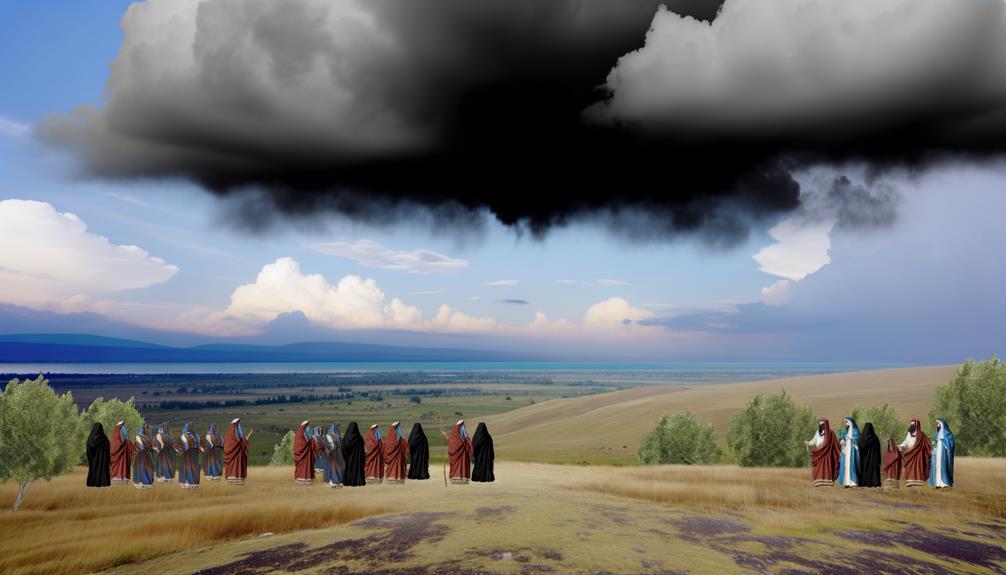
In the New Covenant, dark clouds continue to symbolize divine intervention, often associated with the return of Christ and the final judgment.
In the Book of Revelation, the Apostle John describes a vision where Christ returns ‘with the clouds’ (Revelation 1:7), symbolizing both His majestic arrival and the impending judgment.
Similarly, in Matthew 24:30, Jesus foretells His return with ‘the clouds of heaven,’ underscoring the eschatological significance.
These references evoke awe and reverence, drawing from Old scripture imagery while reinforcing the New scripture’s themes of divine justice and redemption.
Consequently, dark clouds serve as potent symbols, heralding the culmination of God’s salvific plan and the establishment of His eternal kingdom.
Connection to God’s Power
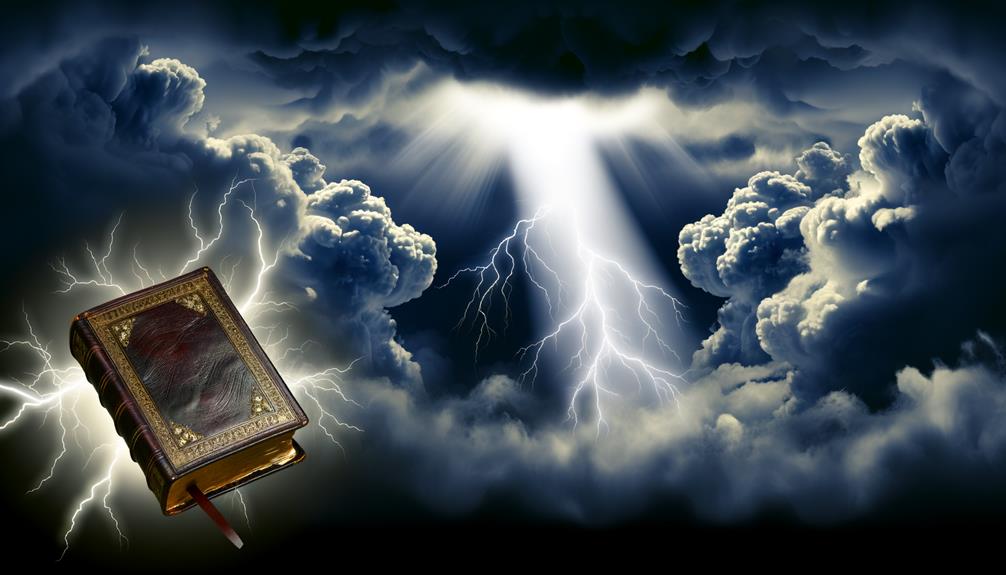
Dark clouds often manifest in biblical narratives as tangible expressions of God’s omnipotence and divine authority. Scriptural references such as Exodus 19:9, where God descends on Mount Sinai in a dense cloud, underscore the profound connection between dark clouds and divine power. This theophany symbolizes God’s formidable presence and His control over creation.
Similarly, in 1 Kings 8:10-11, the appearance of a cloud filling the temple during Solomon’s dedication signifies God’s glory and sanctity. These instances illustrate that dark clouds are not mere meteorological phenomena but are imbued with theological significance, representing God’s majestic and unassailable power.
Consequently, the recurring motif of dark clouds in Scripture serves to remind believers of the awe-inspiring might and sovereignty of the Divine.
Human Response to Divine Signs

Human responses to divine signs such as dark clouds are multifaceted, encompassing recognition of divine omens, varied emotional reactions, and diverse spiritual interpretations.
Scriptural accounts reveal how individuals and communities have historically perceived such signs as manifestations of God’s presence or judgment, often with profound emotional and spiritual implications.
Recognizing Divine Omens
The interpretation of dark clouds as divine omens often hinges on scriptural precedents and theological insights that guide believers’ responses to these celestial signs. In the Bible, dark clouds frequently symbolize God’s presence and power, as seen in Exodus 19:9, where God descends upon Mount Sinai in a thick cloud.
Such phenomena are not merely meteorological but are imbued with spiritual significance. Believers are urged to discern these omens through prayer and scriptural study, seeking alignment with divine will.
Jeremiah 4:28, for instance, uses dark clouds to foreshadow impending judgment, urging repentance. Consequently, recognizing divine omens involves a disciplined engagement with scripture, fostering an interpretative framework that balances reverence and discernment.
Emotional Reactions Explained
Believers often experience a profound emotional response to divine signs, which can range from awe and reverence to fear and introspection. This emotional response is deeply rooted in their understanding of biblical narratives and theological teachings.
Scripturally, dark clouds often signify God’s presence or impending judgment, as seen in Exodus 19:9, where God’s voice emerged from a dark cloud on Mount Sinai. This manifestation can evoke reverence due to its association with divine authority and holiness.
Conversely, fear may arise from the ominous connotations of judgment or divine wrath, as depicted in Ezekiel 30:3. Such emotional reactions underscore the complex interplay between divine revelation and human perception.
This highlights the depth of spiritual engagement and the weight of scriptural symbolism in the believer’s psyche.
Spiritual Interpretations Varied
Scriptural narratives reveal that interpretations of divine signs, particularly dark clouds, vary widely among believers, influenced by theological perspectives and personal experiences. These interpretations can be seen as reflections of one’s understanding of God’s nature and intentions.
- Symbol of Divine Judgment: Some view dark clouds as harbingers of God’s impending judgment or wrath, as illustrated in the Old Scriptures.
- Manifestation of Divine Presence: Others interpret them as manifestations of God’s majestic presence, akin to the cloud on Mount Sinai.
- Call to Repentance: Certain believers see them as a call to repentance and spiritual awakening.
Such varied interpretations underscore the multifaceted nature of spiritual symbolism in biblical texts.
Interpretations in Christian Theology
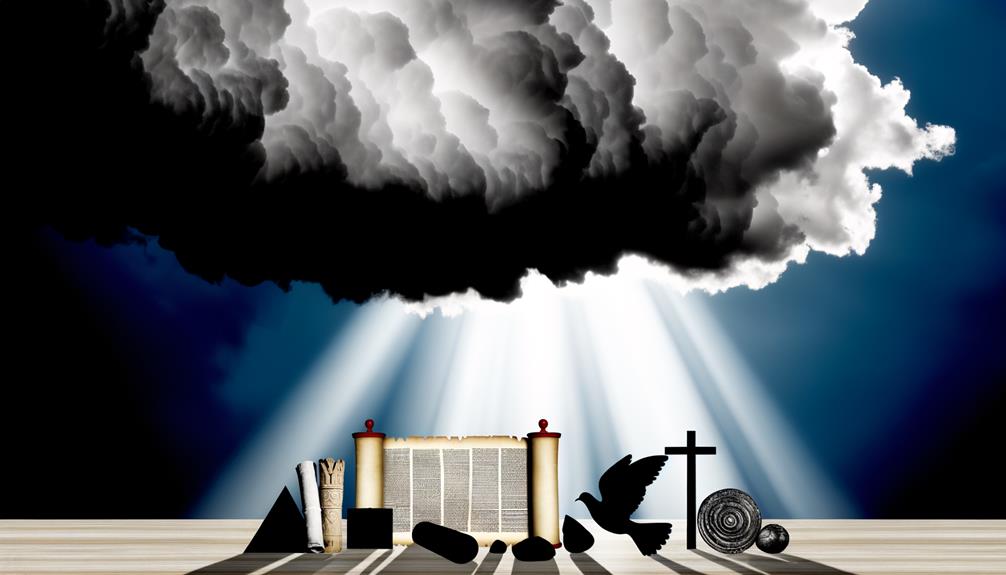
In Christian theology, dark clouds often symbolize the presence and majesty of God, as well as moments of divine intervention and revelation. Scriptural references such as Exodus 19:9, where God appears to Moses in a thick cloud, underscore the concept of divine envelopment.
The dark cloud signifies both concealment and revelation, serving as a medium through which God’s voice is heard and His will made known. This duality conveys a profound theological message: the mystery and awe of the divine.
| Scripture Reference | Symbolism | Theological Implication |
|---|---|---|
| Exodus 19:9 | Divine Presence | God’s majesty and authority |
| 1 Kings 8:10-11 | Temple Glory | God’s dwelling among His people |
| Psalm 18:11 | Concealment | The inscrutability of God’s ways |
| Revelation 1:7 | Second Coming | Christ’s return in divine power |
Conclusion
In the grand tapestry of biblical scripture, dark clouds serve as an allegorical veil, shrouding the divine in both majesty and mystery. They signal God’s formidable presence on Mount Sinai, foreshadow prophetic judgment, and underscore divine concealment.
These ominous clouds, threaded throughout both Old and New Scriptures, symbolize the awe-inspiring power of the Almighty. Within Christian theology, these celestial phenomena prompt a profound human response, inviting contemplation and reverence for the ineffable nature of God’s will.






